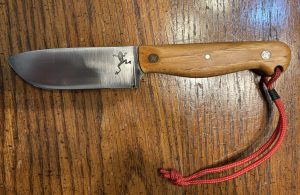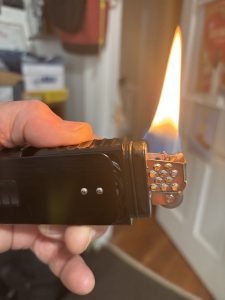
A SMART NORTHWOODS SURVIVAL KIT

My first job after college was as a forester for the Bureau of Land Management in Coos Bay, Oregon. One rainy January morning I was re-marking the cutting line that defined the area of a timber sale. It was Thursday and I had Friday off and big plans for the weekend, so I hurried to get the job done.
Space doesn’t permit details other than to say that what I did was incredibly stupid, and within the hour I became hopelessly lost. And lost in an Oregon rain forest is a very big deal. Here, huge trees cloud the sky, and downed trees and winding vegetation limit movement to at best, one mile an hour. Visibility is measured in feet; only occasionally can you see the sky. Walk a few yards off a beaten path and you may become hopelessly lost. This was in 1962, long before GPS and cell phones.
Since it was Friday, no one from the BLM would look for me until Monday when I didn’t show up for work. So instead of waiting for help (and being embarrassed when found), I decided to find may way out. I had these “survival items” on my person:
- A Thermos of coffee and lunch
- Matches and a Zippo cigarette lighter
- A Silva Ranger compass
- A sturdy pocket knife
- A roll of yellow surveying ribbon (to re-mark the sale area)
- A red cowboy bandana
- Pencil and spiral notebook
I was wearing a cotton T-shirt, a wool long sleeve shirt and a Filson cruiser’s vest; Filson tin-pants, a two-piece rain-suit, metal hard hat, and corked boots for safety while walking on logs.
Most important, I had a “mental map” of the area: For example, I knew that highway 101, which parallels the ocean, was about 20 miles west of me. If I headed west, I should make the highway in a few days. Backtracking to the winding, unimproved mountain road where I’d parked the Jeep (about a mile away) was out becauseI had no idea where I was. Besides, the road ran roughly east to west and it curved around so even if I had a proper bearing, my chances of intersecting it were small.
Momentarily, I panicked and started to run. Then I sat down under a tree, poured some coffee and formulated a plan. I decided to go for the highway. I figured I could make about eight miles a day. It was January (the rainy season) so there was standing water everywhere. I wouldn’t be thirsty. And I had packed a big lunch—enough for two days if rationed.
I set my compass for due west and started walking. When it became dark, I cut a some Douglas fir boughs, piled them up and crawled between them. Surprisingly, I was reasonably comfortable and never cold. I headed west as soon as the sun came up.
Two-and one-half days later I intersected a logging road which I followed to the tiny town of Remote, Oregon (yes, that’s its real name! The town was recently put up for sale for 3.5 million dollars. For another half-million you can have the school!). There, I hitched a ride on a logging truck back to my jeep then I drove home. I never told a soul. Why? Because foresters don’t get lost!
COMMERCIAL SURVIVAL KITS ARE A WASTE OF MONEY!
A commercial “survival kit” would not have helped me in any way. It’s what I had in my pockets that saved the day:
- A mental map that said safety was about two days “west”.
- A compass to keep me heading in the right direction.
- Food for two days, if I rationed it.
- A knife, which I used to cut pine boughs for a bed and cover.
- Matches/lighter: I never built a fire—the woods were too wet. Even if I could have built one, no one would see the smoke—mist and fog obscured the sky.
A positive mental attitude (PMA) – knowing you’ll survive – beats any commercial “survival kit.” That highway 101 was within reach was the fuel that kept me going. Without this knowledge, the most complete survival kit would have been useless. Indeed, in a real emergency, a commercial survival kit will probably be left behind or lost in the gathering flow if your canoe or kayak capsizes. More than likely, you’ll have to rely on just “what’s in your pockets.”
Commercial survival kits commonly contain these items: waterproof matches and fire-starters, a single-edged razor blade or cheap knife, a near worthless miniature compass, a lightweight space blanket, fish-hooks, fish line, aluminum foil, signal mirror, whistle, sewing needle and thread, band-aids. Maybe some energy bars and salt. And of course, an “instruction manual”.
Contrast this with what wilderness paddlers should always have on their person:
- Waterproof matches and/or a waterproof butane cigarette lighter (I carry two butane lighters).
- Sturdy knife—fixed or folding blade
- A seriously good compass, preferably with a mirror (for signaling)
- A paper map—or at least a mental map of the area
- Large colorful cowboy bandana
- Insect head-net (if tripping in the north country) and bug dope
- whistle
A SMART SURVIVAL KIT FOR THE NORTH WOODS
Let’s say you’re going in harm’s way—perhaps solo canoeing a remote northern river where help is days away. Here’s what I would carry. All will fit into a small fanny pack that buckles around the waist:
- SPOT satellite messenger. Extra batteries. All sealed in a Loksak® waterproof plastic bag.
- A few heat-tabs (fire starters)
- Disposable butane lighter—sealed in plastic wrap (this is in addition to the one in your pocket)
- 50 feet of 1/16” inch diameter nylon cord, cut into 10 foot lengths. Learn the quick-release “sheetbend” knot and you can daisy-chain ’em for added length.
- Two Band-Aids
- 4 feet of duct tape or Gorilla tape wound around a pencil stub.
- Two sheets of paper torn from a small waterproof notebook.
- Two fish-hooks and one jig. Fifty feet of high-test fishing line.
- 2 ultra-compact space blankets (each, about the size of a pack of cigarettes).
- Small roll of brightly colored plastic surveying tape.
- Small steel or titanium cup—a Sierra cup is ideal.
- Some bouillon cubes in a waterproof bag.
- Optional: small coil of snare wire
- One or two energy bars, if space permits.
Add these items to what should be “on your person” and you’re good to go. Note that I prefer the SPOT over the DeLorme inReach. Why? Because SPOT is lighter, more compact and less expensive to buy and operate. It alone will bring rescuers fast. Use the surveying tape to create a trail rescuers can follow if you wander. Boil water and prepare bullion soup, spruce or fireweed tea in your tin cup. Fish you catch can be hung from a tripod over the fire or filleted, cut into chunks and boiled in your cup. The space blankets can be taped together and rigged to provide shelter. An insect head-net can double as a net to catch crawdads and minnows.
If you’ve ever been lost or, as Daniel Boone once said, “I was never lost, just confused once for three days,” I’d love to hear your views on this advice.

